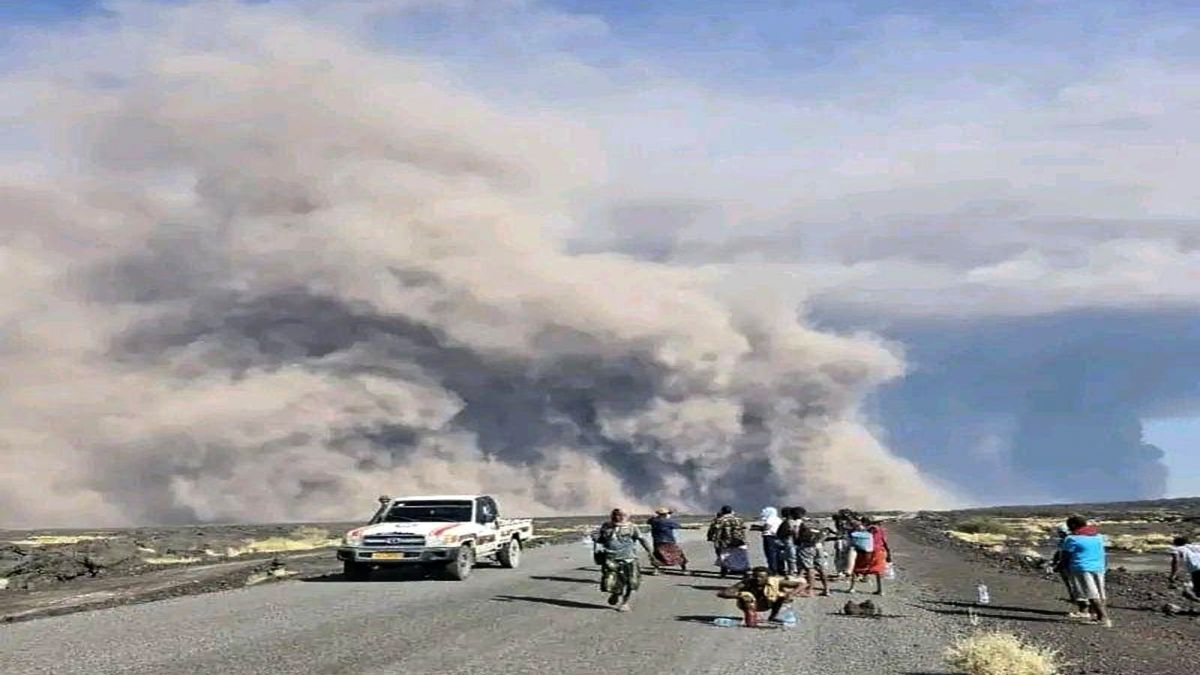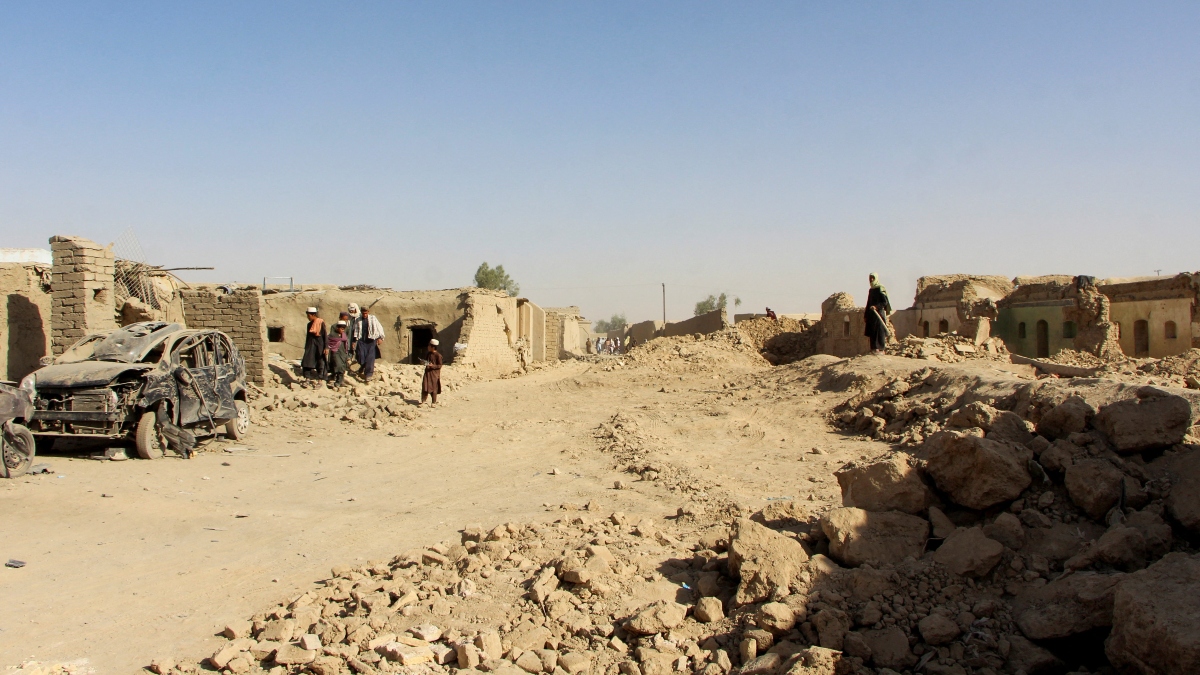Ash-tonishing! After 12,000 years, a volcano has erupted in Ethiopia’s north-eastern region, sending thick plumes of smoke across the Red Sea towards Yemen, Oman, India and parts of northern Pakistan.
And with thick plumes of volcanic ash coming our way, authorities in India are bracing potential disruption to air travel as well as air pollution levels spiking across parts of north India, which are already choking on toxic air.
So, how bad is the situation expected to be after the Hayli Gubbi volcano eruption? How will the volcano eruption in Ethiopia be felt in India?
Dormant volcano erupts in Ethiopia after 12,000 years
On Sunday morning (November 23), a long-dormant volcano, the Hayli Gubbi, in northern Ethiopia erupted sending plumes of ash into the skies. Describing the moment the eruption took place, Ahmed Abdela, a resident of the Afar region, said it “felt like a sudden bomb had been thrown”. Many people who had been heading to the Danakil desert, a local tourist attraction, were left stranded in ash-covered Afdera on Monday, he said.
Fortunately, no casualties were recorded following the eruption. However, local official, Mohammed Seid said that the eruption could have economic implications for the local community of livestock herders. “While no human lives and livestock have been lost so far, many villages have been covered in ash and as a result their animals have little to eat,” he said.
Notably, this is the first time in 12,000 years that Hayli Gubbi has erupted with images showing towering plumes of ash emerging from the volcano’s summit. Experts say that Hayli Gubbi is a shield volcano, like Hawaii’s Mauna Loa. These volcanoes are known for oozing lava flows, not expelling giant columns of ash.
As Juliet Biggs, an earth scientist at the University of Bristol in England, told Scientific American: “To see a big eruption column, like a big umbrella cloud, is really rare in this area.”
Ethiopian volcano ash moves toward India
Following the eruption in Ethiopia, plumes of thick smoke began to move across the Red Sea and by Monday night, around 11 pm, reached Delhi, the capital of India. Forecasters had been tracking the cloud for a day, as it made its way to the Capital — travelling at 130 kmph.
Weather trackers said the plume first entered India over western Rajasthan. “The ash cloud has now entered the Indian subcontinent from the Jodhpur–Jaisalmer region and is moving northeast at 120–130 kmph,” the India Met Sky Weather alert said. “Skies may look weird and funny for a while, but there is less to worry about as the ash lies between 25,000 and 45,000 feet.”
By late Monday evening, the plume had stretched over parts of Rajasthan, Haryana and Delhi. Forecasters have noted that the volcanic ash will enter Gujarat this evening by 10 pm and then move to northwest Maharashtra, Delhi, Haryana, and Punjab, and later it will impact the Himalayas and other regions.
“This is between 15-25,000 up to 45,000 feet up in the sky and contains mostly volcanic ash, sulphur dioxide and some small particles of glass/rock which will make the sky appear darker and impact air traffic and air route which will bring delays and longer travel. The ash cloud is about to enter Gujarat (west side) and move towards Rajasthan NW, Maharashtra, Delhi, Haryana and Punjab by 10 pm and later it will impact the Himalayas and other regions. It will make the sky appear darker and hazier than usual and people may send us pics of the sky if possible,” wrote IndiaMetSky Weather on X.
Flights affected by volcanic ash
With the volcanic ash drifting over north India, India’s aviation regulator, the Directorate General of Civil Aviation (DGCA), issued an advisory to airlines and airports to deal with possible disruptions caused by it. The DGCA in its advisory instructed airlines to strictly avoid published volcanic ash affected areas and flight levels, adjust flight planning, routing and fuel considerations based on the latest advisories.
It further stated that airlines have been instructed to immediately report any suspected ash encounter, including engine performance anomalies or cabin smoke/odour. The DGCA have asked the operators to ensure continuous monitoring of the situation related to the volcanic ash cloud and stay updated through satellite imagery and meteorological data, among other things.
In fact, the volcanic eruption has already led to significant air travel disruption. Akasa Air, IndiGo and KLM are among the airlines that have cancelled flights due to the volcanic ash issue.
Akasa Air said its flights to and from Jeddah, Kuwait, and Abu Dhabi scheduled for November 24 and 25 have been cancelled due to the ash plume. KLM Royal Dutch Airlines have also cancelled its Amsterdam-Delhi service (KL 871) and the return Delhi-Amsterdam flight (KL 872) due to the ash cloud.
Meanwhile, IndiGo, in a post on X, said, “Following the recent eruption of the #HayliGubbi volcano in Ethiopia, ash clouds are reported to be drifting towards parts of western India. We understand that such news may cause concern, and we want to reassure you that your safety remains our highest priority.”
As a result of the volcanic ash cloud, IndiGo’s Kannur-Abu Dhabi 6E 1433 diverted to Ahmedabad on Monday afternoon to avoid flying into the route of the plumes.
SpiceJet also noted on X, “Due to a volcanic eruption in Ethiopia, volcanic ash activity has been reported across parts of the Arabian Peninsula. This may impact flight operations for aircraft flying through these regions. As safety remains our top priority, our flight operations and safety teams are closely coordinating with aviation authorities and continuously monitoring ash cloud movement. Passengers travelling to/from Dubai (DXB) are advised to keep a check on their flight status,” adding that safety teams are coordinating with aviation authorities. Passengers travelling to and from Dubai have been advised to check their flight status.
An aviation official was quoted as telling Hindustan Times that the ministry officials as well as the DGCA were keeping a close eye on the matter. “If the ashes settle over Delhi and Jaipur by Tuesday, Indian aviation is expected to be impacted severely,” he added.
Air India also saw several of their flights cancelled on November 24 and November 25 as a result of the volcanic ash.
Impact of volcanic ash on air pollution
The Ethiopia volcano ash, which has made its way to India, has created a thin, hazy layer over parts of Delhi and Haryana, causing more concern of its impact on the already poor air pollution levels.
However, officials have noted that the volcanic plume is not expected to significantly affect Delhi’s pollution levels, as it is travelling at very high altitudes. IMD director general M Mohapatra was quoted as telling Hindustan Times that “it was unclear whether it will impact air quality, but any significant impact is unlikely as it is at higher levels.”
He explained that the impact of the ash cloud would be mainly felt in aviation. He noted that since the plumes were in the “upper levels, its effect near the surface would be limited”. “The skies will appear as hazy and cloudy,” he further said, adding that cities may also see “a marginal rise in the temperature” as the ash mass behaves like cloud cover.
However, regardless of the volcanic eruption, Delhi’s air quality remains a concern. On Tuesday morning, thick smog blanketed areas around India Gate and Kartavya Path, with the Air Quality Index (AQI) reading 328, categorised as ‘very poor’ by the Central Pollution Control Board (CPCB).
With inputs from agencies


)

)
)
)
)
)
)
)
)



